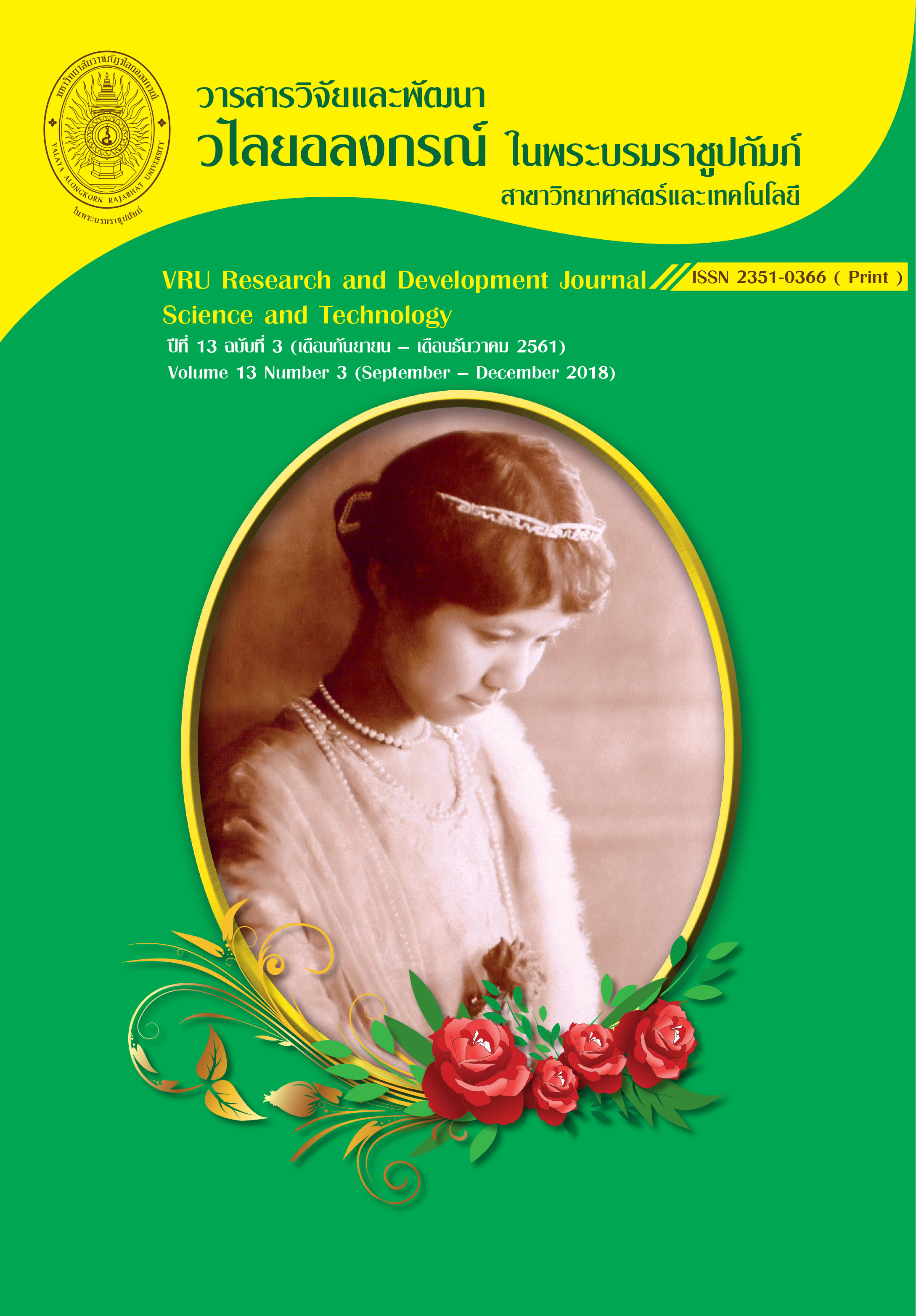DEVELOPMENT OF BACTERIAL CELLULOSE PRODUCTION FROM HERBAL JUICES
Main Article Content
Abstract
The objective of this research was to develop the bacterial cellulose production from four herbal juices including Galingale (Boesenbergia pandurata (Roxb.)), Moringa (Moringa oleifera Lam.), Lemon grass (Cymbopogon citrates (DC.) Stapf) and Ginger (Zingiber offcinale Vern.). The bacterial celluloses were produced by using Acetobacter xylinum TISTR975 and investigated the optimal amount of coconut juice and juice. Four recipes including 1) coconut juice 100%, 2) coconut juice 75%: herbal juice 25%, 3) coconut juice 50%: herbal juice 50% and 4) coconut juice 25%: herbal juice 75% were evaluated the physical, chemical, microbiological properties. Bacterial cellulose was produced in plastic box containing culture medium for 10 days at room temperature. The results showed that thickness and firmness were decreased when amount of herbal juice increased significantly. The highest thickness was gained from ratio of 75% of coconut juice: 25% of herbal juice. Bacterial cellulose from Moringa juice has highest thickness (1.29 + 0.01 cm.) follow by Lemon grass, Galingale and Ginger, respectively. Proximate analysis including moisture, ash, fat, protein and fiber were investigated and revealed that their were not significantly different (p> 0.05) in all recipies. For antioxidant analysis, the result revealed that increasing amount of herbal juice was significantly increased % DPPH (p< 0.05). However, the ratio of coconut juice: herbal juice at 75:25 was selected as a recipe for produced bacterial cellulose. The sensory evaluation of the finish products were also done by 35 panelist and result showed that bacterial cellulose from Lemon grass juice has highest score of overall acceptability. Moreover, the physical and microbiological properties of the bacterial cellulose from herbal juice in this study were accepted base on the Thai community product standard (341/2547).
Downloads
Article Details
Copyright Notice
The copyright of research articles published in the VRU Research and Development Journal Science and Technology Journal belongs to the Research and Development Institute, Valaya Alongkorn Rajabhat University under the Royal Patronage. Reproduction of the content, in whole or in part, is prohibited without prior written permission from the university.
Responsibility
The content published in the VRU Research and Development Journal Science and Technology Journal is the sole responsibility of the author(s). The journal does not assume responsibility for errors arising from the printing process.
References
กาญจนา ชินสำราญ และ ฤทัยรัตน์ สุทธิสุวรรณ. (2558). การพัฒนาการผลิตเซลลูโลสจากแบคทีเรียในกากน้ำตาลโดยใช้น้ำมะพร้าวเป็นสารอาหารเสริมและการเติมสารที่ทำให้เกิดเจล. วารสารวิชาการ มทร.สุวรรณภูมิ. 3(2) :98-108.
เกรียงไกร พัทยากร, อรัญญา พรหมกูล และ วรรณทิชา เศวตบวร.(2558). คุณลักษณะของแบคทีเรียวุ้นสวรรค์ที่ผลิตได้จากแก้วมังกร. แก่นเกษตร. 43(ฉบับพิเศษ 1): 917-921.
พัฒนพงษ์ วันจันทึก (2543). การผลิตเซลลูโลสจากน้ำคั้นจากเปลือกสับปะรดโดยเชื้อ Acetobacter sp. วิทยานิพนธ์ปริญญาโท สาขาเทคโนโลยีชีวภาพ มหาวิทยาลัยเกษตรศาสตร์ กรุงเทพฯ.
วิจิตรา ใหม่เจริญ, พิชามญชุ์ กำมังละการ, สุวรรณา สุดปรึก, กุลนันท์ ปุ๊ดพรหม, ชุติมา อันชนะ, จันทร์ทิมา พงษ์พานิช และสุรศักดิ์ ละลอกน้ำ. (2555). การผลิตเซลลูโลสจากแบคทีเรีย Acetobacter xylinum TISTR086 โดยใช้ผลผลิตทางการเกษตรเป็นแหล่งคาร์บอน. วารสารหน่วยวิจัยวิทยาศาสตร์ เทคโนโลยีและสิ่งแวดล้อมเพื่อการเรียนรู้. 3(2): 92-97.
Association of Official Analytical Chemists (AOAC). (2000). Official methods of analysis of AOAC international (17th edition). AOAC International, Gaithersburg, MD.
Castro C., Zuluaga, R., Putaux, J-L., Caro, G., Mondragon, I., Ganñán, P.(2011). Structural characterization of bacterial cellulose produced by Gluconacetobacter swingsii sp. From Colombian agroindustrial wastes. Carbohydrate Polymers. 84: 96-102.
FDA- Bacteriological Analytical Manual (BAM) (2001). “Yeasts Molds and Mycotoxins.” in Chapter18.[Online].Available:https://www.fda.gov/Food/FoodScienceResearch/LaboratoryMethods/ucm071435.htm
Jagannath, A., Kalaiselvan, A., Manjunatha,S.S., Raju, P.S., Bawa, A.S. (2008). The effect of pH, sucrose and ammonium sulphate concentrations on the production of bacterial cellulose (Nata-de-coco) by Acetobacter xylinum. World Journal of Microbiology and Biotechnology. 24:2593–2599.
Kamal, M., Hossain, I, Shikha, S., Neazuddin, M., Bapary, M., Islam, M.N. (2005). Effect of salt concentration and Cryoprotectants on gel-forming ability of surimi prepared from Queen fish (Chorinemus lysan) during frozen storage. Pakistan Journal of Biological Science. 8(6): 793-797.
Keshk, S.M.A.S., Razek, T.M.A., Sameshima, K. (2006). Bacterial cellulose production from beet molasses. African Journal of Biotechnology. 5 (17): 1519-1523.
Kurosumi, A., Sasaki. C., Yamashita, Y. Nakamura. Y. (2009). Utilization of various fruit juices as carbon source for production of bacterial cellulose by Acetobacter xylinum NBRC 13693. Carbohydrate Polymers. 76 (2):333-335.
Nilsang, S. (2015). Antioxidant activity and total polyphenol content in Thai Herbal fermented juices. In the proceeding of the 2015 International forum in Agriculture, Biology and Life science (IFABL2015) on June 23-25, 2015. Sapporo, Japan.
Nilsang, S.,(2016). Chemical and Microbiological properties in Indian Gooseberry (Phyllanthus emblica Linn.) fermented juice producing by Household Process in Thailand. In the proceeding of The 4th International Symposium on Fundamental and Applied Science (ISFAS 2016) on 29 March- 1 April, 2016. Kyoto, Japan.
Nilsang S. (2017). Physical and chemical characteristics of Nata de coco mixed with Gac fruit (Momordica cochinchinensis) juice. In the proceeding of Asia-Pacific Conference on Life Science and Biological Engineering (APLSBE2017) on March 29-31, 2017. Nagoya, Japan.
Nilsang S. (2018). Effect of spray drying temperature on quality of instant herbal drinks. Food and Applied Bioscience Journal. 6(special issue): 55-68.
Puranik, V., Mishra, V., Yadav, N, Rai, G.K. (2012). Bioactive components retention in processed indian gooseberry products. Journal of Food Process & Technology. 3:194, doi:10.4172/2157-7110.1000194.
Wenno, M.R., Wattimena, M.L., Rumakey, Z.A., Thenu, J.L. (2015). Physic and chemical characteristics of Nata de seweed from Eucheuma cottonii and Gracilaria sp. DOI.: https://dx.doi.org/10.18502/kls.vli0.77.


